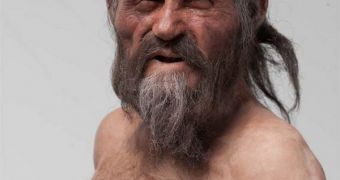A team of forensics artists have recently finished reconstructing the face of an ancient mummy, that was discovered buried in ice in the Italian Alps. The Iceman, which is believed to have lived some 5,300 years ago, has been named Ötzi.
Currently, he resided in the South Tyrol Museum of Archeology, where visitors can see the mummy during visiting hours. The museum management decided to give the Iceman the chance to look his best for his visitors.
As such, officials commissioned Dutch brothers Adrie and Alfons Kennis, who are both reconstruction artists, to give Ötzi back his face. They reconstructed it using 3D images of the man's skull, forensics evidence and artistic approaches.
The result is a man that looks strikingly familiar to us. There are of course slight differences, but they are most likely caused by the fact that the man spent most of his life among the ices, and did not experience warm and sunny climates very often.
This is why his skin was all weathered, and his hair about to turn into dreads. Among the most striking features on the new reconstruction are the long nose Ötzi has, as well as his deep-set eyes. This adaptation may have helped him deal with the harsh conditions in the ice fields where he lived.
His mummy was found on the Austrian-Italian border, in a region called the Ötztal Alps (hence the name). The remains were found by a group of hikers back in 1991, and they have been under investigation ever since.
Interestingly, a past investigation has demonstrated that the mummy was most likely buried at that location. Until then, scientists believed that a blizzard had caught Ötzi off-guard, burying him under feet of snow at the age of 46, LiveScience reports.
But clues related to markings on Otzi's body did not support a hypothesis in which he was entombed by massive precipitations, scientists said.
The forensics data appear to indicate that the man was buried at the location during the summer months, by a group of related humans, and during a ceremonial ritual.
The idea is supported by studies of Otzi's possessions, which were discovered near him. These include a backpack, a copper ax, a container, a dagger and a bow. At first, researchers believed that the man had discarded and scattered these objects as he was dying.
But analysis of the surrounding area revealed that the objects were in fact placed carefully near the body, on a stone platform built especially for this goal.

 14 DAY TRIAL //
14 DAY TRIAL //